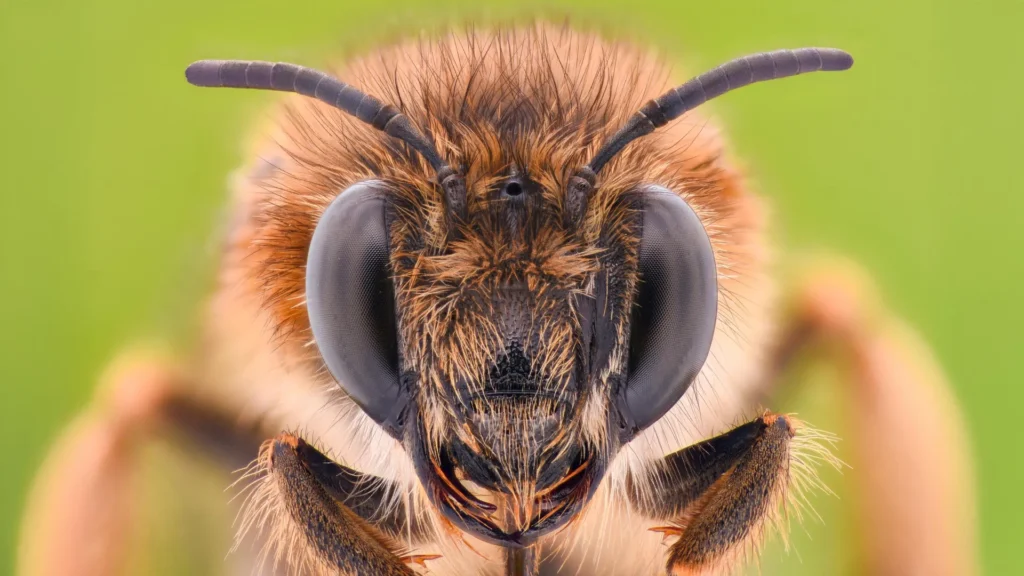When we think of advanced intelligence, we often imagine massive supercomputers, billion parameter AI models, or the human brain with its 86 billion neurons. Yet, new research suggests that one of the greatest secrets to artificial intelligence might lie inside one of nature’s smallest creatures the honeybee.
A groundbreaking study from the University of Sheffield has revealed how tiny bee brains use flight movements to process complex visual information with astonishing accuracy reshaping how scientists think about both AI and robotics.
This discovery doesn’t just change how we see insects it could redefine the future of machine learning, robotics, and artificial intelligence as a whole. Bees are famous for their navigation skills, their ability to recognize flowers, and even their capacity to remember human faces.
Despite having fewer than one million neurons a fraction of the human brain the bee demonstrates remarkable intelligence in solving visual and spatial problems. The University of Sheffield study built a digital model of a bee’s brain and discovered something fascinating bees rely heavily on their flight movements to help process visual information.
Instead of passively observing the world, bees move in specific ways hovering, darting, and circling to generate brain signals that make recognition of patterns and objects more efficient. In other words, the intelligence of tiny bee brains is not just in the neurons but in the combination of movement, body, and environment.
Rethinking AI Lessons from Nature
Artificial intelligence today often relies on massive datasets and enormous computational power. For example, OpenAI’s GPT models or Google’s DeepMind systems consume huge amounts of energy and require powerful GPUs. This brute force approach works, but it is inefficient and unsustainable.
Bees show us a different path: by actively engaging with the environment, intelligence can emerge with far fewer computational resources. Instead of relying on sheer size, bees depend on efficiency and strategy.
This insight is particularly exciting for robotics. Imagine future drones, delivery bots, or search and rescue robots equipped not with heavy computing needs, but with bee inspired intelligence smart enough to recognize complex patterns with minimal processing power.
To understand the real world implications, let’s compare bees with current drone technology. Modern drones Require GPS, lidar, and advanced sensors to navigate and recognize objects. They need powerful processors to analyze data in real time, draining energy quickly.
Can fly miles away, recognize landmarks, communicate with their hive, and return home using only a brain smaller than a sesame seed. The case study of drone navigation highlights the inefficiency of current AI models.
By studying how bees manage complex visual recognition with minimal neurons, engineers could design drones that require less battery power, fewer sensors, and lighter computing hardware leading to longer flight times and greater independence.
Bridging Biology and AI
Dr. Andrew Philippides, a leading researcher in computational biology, has often noted that insects are nature’s minimalists. He argues that understanding how tiny bee brains solve problems could help AI researchers design algorithms that mimic these natural efficiencies.
Similarly, Professor James Marshall, who led the Sheffield study, explains. The key lesson here is that intelligence does not come from raw computing power alone. It comes from how the brain, the body, and the environment interact. Bees are showing us that movement itself is part of thinking.
These expert insights underline a shift in how AI development is being viewed. Instead of simply scaling bigger models, researchers are now exploring bio inspired intelligence, where efficiency, adaptability, and embodiment are central.
As someone who has observed bees closely in my garden, I’ve been struck by their persistence and precision. Watching a bee hover in front of a flower, adjusting its angle before landing, I realized it wasn’t just random movement it was active learning in action.
That experience helped me connect with this research on a deeper level. Bees are not just surviving they are constantly calculating, analyzing, and adapting with elegance and efficiency.
It made me wonder if nature can achieve this with so little, why do we humans overcomplicate intelligence with excessive machinery? This personal perspective echoes a broader truth: sometimes, simpler systems are smarter systems.
Why This Discovery Matters
The implications of bee inspired AI reach across multiple industries. Surgical robots could become lighter, faster, and more precise if they adopt bee style visual processing. Instead of relying on massive neural networks, they could adapt to the environment with real time micro movements.
Self driving cars currently depend on enormous data centers and sensors. Bee inspired navigation could allow vehicles to interpret surroundings more efficiently, reducing both energy use and costs.
Drones inspired by tiny bee brains could revolutionize crop monitoring, pest control, and pollination. By mimicking bees’ natural efficiency, they could perform tasks without draining resources.
In dangerous environments like collapsed buildings or combat zones, robots with bee style intelligence could navigate tight spaces and make smart decisions without constant human input.
Future of AI Small Brains, Big Impact
The key idea behind this study is that intelligence is embodied. Instead of separating brain, body, and environment, bees integrate all three into a seamless system. That’s why their small brains can accomplish what would otherwise require massive computing power.
This could represent a paradigm shift in AI. Instead of chasing bigger models with higher costs, researchers might start building smaller, more efficient and adaptive AI systems smarter not because they are larger, but because they are more biologically inspired.
The discovery of how bees use movement to enhance visual learning challenges our assumptions about intelligence. It teaches us that. Intelligence is not about size but efficiency and adaptability. Movements and interactions with the environment are part of thinking itself.
The future of AI may lie not in massive computing power but in nature’s smallest teachers. If tiny bee brains can recognize complex patterns, navigate miles, and adapt to changing environments with such elegance.
Then perhaps the future of artificial intelligence isn’t about creating supercomputers but about learning from the smallest creatures among us.

